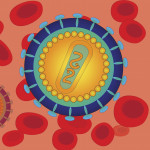A number of friends have reached out and congratulated me on there being an HIV cure. They had clicked on a headline for its flashy wording, then contacted me because they know that I work passionately to help end to this epidemic and find a cure. Granted, these friends don’t work in the HIV field like I do, but I feel for them because I’ve been there too I’ve been pulled in by a catchy headline only to read the article and be let down.
The fact is that we don’t have a cure for HIV. Yet. But that doesn’t mean there isn’t a lot of good news related to this subject. In a world with so little knowledge about the virus, it’s paramount that we get the good news out there to the community. We need more translators who can help us understand where we are in regards to finding a cure.
This ends up being one of the most important pieces when reporting about HIV science. While contemporary medical journals are filled with jargon-laden articles, they are often written in such a way that you practically have to be a cryptologlist or an expert code breaker to understand what they are trying to reference. It is important that in the quest to report on what’s happening, we don’t present all our finding in these cryptic pieces. But at the same time, in trying to help the public understand the science, we need to write titles and headlines that accurately say what’s happening.
While I wait for the day when I can firmly say there is a cure for HIV, I know the truth of the science is it’s never that easy. And headlines like the one below give us a misplaced idea of what’s going on:
Have we found a cure for HIV? Five patients are ‘virus free’ months after new vaccine
What does this title say to you? Does it make you think we have a cure?
They could have gone with a headline like the one below. It is less flashly but does tell a more honest assessment of the trial. It still maintains the idea of work happening in the cure space and that the work is new. But doesn’t seem to over promise anything. Unlike this kind of title:
Some old drugs and a new vaccine might point the way toward early signals for a possible HIV cure
Nerdy folks, like me, want you to understand what’s happening in HIV. We seek to provide the key elements of HIV science, vaccine research, and progress toward a cure in easily digestible pieces. We also hope to prepare you by explaining what to keep in mind when you are reading these articles.
While the news report in the article mentioned above pulls you in with an exciting headline, it’s also a bit misleading. There are several questions to answer in order to understanding cure research. For example, how long does someone have to go without medication to considered cured? Most individuals in the HIV field have heard of the case of Timothy Brown, the first and only person to be cured of HIV. He has been HIV-free for 10 years now. That’s a really important fact because when it comes to cure research, it matters that the cure lasts. Much like cancer that can come back, HIV is also a tricky element given the virus’s ability to hide. It can take a long time to know if HIV is completely gone from someone’s body. Given the very tricky nature of one of the most complicated viruses we have ever encountered, this is challenging.
A few years ago, two adults and one infant were declared to be cured after going long periods with no detectable HIV despite being off antiretroviral therapy, but ultimately they saw the virus come roaring back. With access to modern medicine, individuals living with HIV can have full and healthy lives. However, that life still requires consistent access to medication. A long and healthy life without medication routinely still eludes us.
The scientist following the two adults, when publicly announcing the results about the return of the virus in his patients, said that seeing the viral load test results felt like a punch in the gut. And the patients themselves (one of whom has been interviewed by POZ and another writer about his experience) obviously felt even worse. As a spectator to this rollercoaster, one who has a deep understanding of the underlying science, I found the story confounding at best and emotionally challenging at worst, and I know my friends on social media found themselves even more confused about what to think and feel.
The goal we are striving toward is to give people a life that does not require constant medication. The new strategy discussed in the article above includes data that requires further examination. While it is still early in the design and work, this article offers hope for an HIV-free future. Clinical investments in excess of $100 million U.S. dollars from the National Institutes of Health (NIH) in the United States, the European Union and some of its member states, philanthropic leaders such as amFAR, and the pharmaceutical industry have shown that cure research is worth pursuing and is making its way forward. Along the way, we are also learning more than we ever could about the human immune system and what it takes to beat complex viruses—work that is applicable and necessary in other medical research fields, such as various cancers and other immune-based illnesses.
So the next time you, like me, can’t resist the urge to click on an article based on an exciting headline about HIV cure research, do the following things:
- Look through the article for quotes from reputable scientists and references to a formal study publication. Remember that when we find a cure it will be one of the scientific breakthroughs of the century and that even scientists in the field are going to wait to get their hopes up until their peers have had a chance to review all of the data and research methods under a magnifying glass.
- Pay attention to who published the article. Was it reported in The New York Times or Science magazine? Then you’re probably good. If not, Google the name of the researchers and the intervention they tested and see if it pops up from another reputable source.
- Be a good poker player. If the headline indicates that a cure is just months away, it’s an obvious tell that they’ve got lousy cards and they’re bluffing. Don’t click and don’t share. But if the headline says, “might one day” you’re on safer ground, and it’s at least worth a first look.
- Be skeptical unless the article discloses the total number of people in the study and whether it provides the percentage of those studied who had a good result. Also, see if the researchers say whether and how they think an intervention worked in some and not in others. We have yet to see any trial in humans that is larger than a couple of handfuls of people and none where a potentially positive result was achieved in all of the study participants.
- Look for how long have the participant been HIV-free without medication in their body and what tests were used to determine this. Unfortunately, we’re still flying a bit blind on this one as there is no gold-standard test to predict the size of the hidden HIV reservoir and whether the virus is truly controlled or if it is likely to escape again.








3 Comments
3 Comments